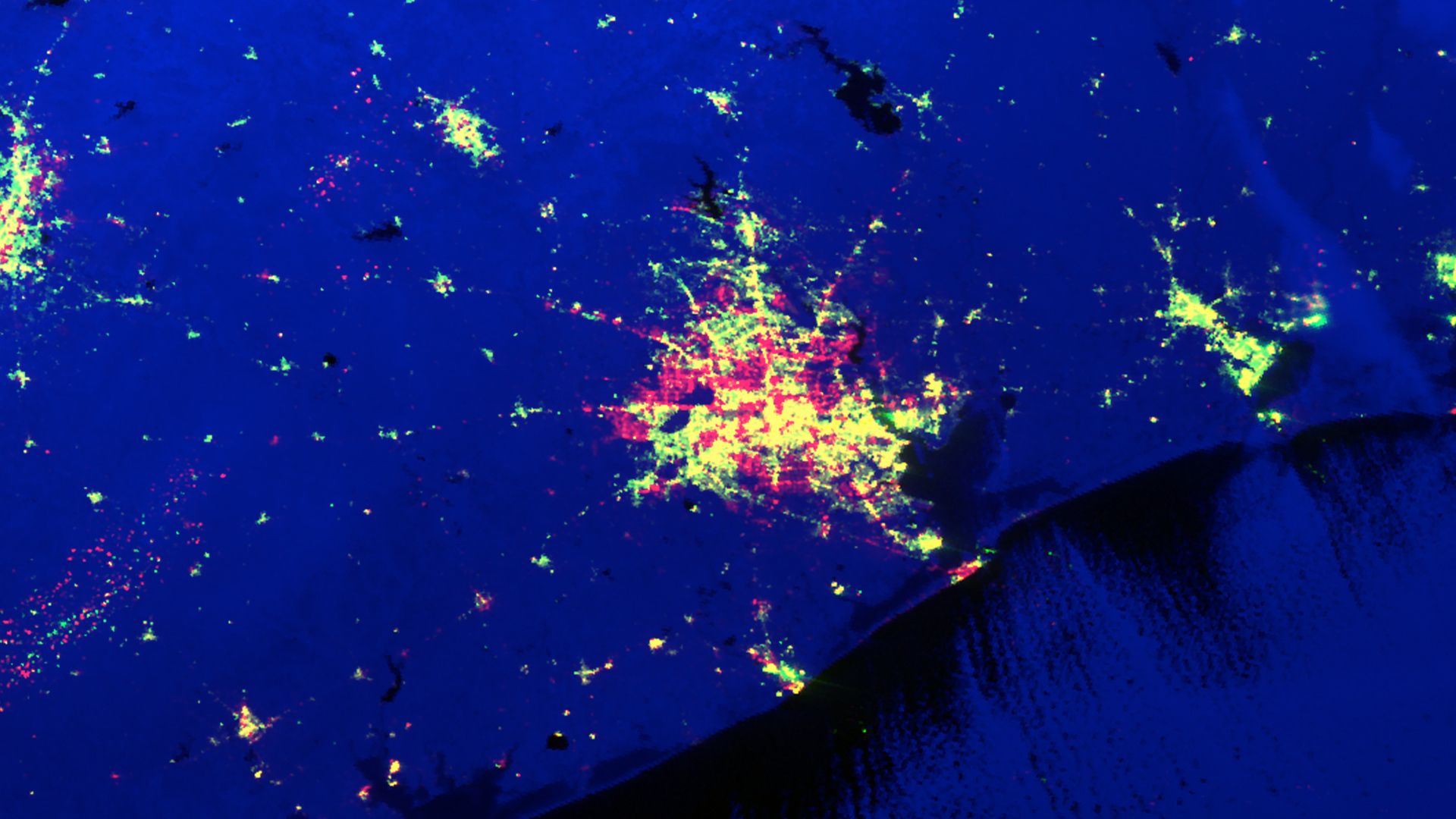| | | | | | | Presented By ExxonMobil | | | | Generate | | By Ben Geman ·Feb 18, 2021 | | Welcome back. Today's Smart Brevity count is 1,202 words, 4.5 minutes. 🎧 The Washington Post's Andrew Freedman joined the Axios Re:Cap podcast to discuss the Arctic blast wreaking havoc on Texas' power grid. Listen here. 🎶 And tomorrow marks exactly 30 years since R.E.M. released today's intro tune... | | | | | | 1 big thing: What's next in the Texas power crisis |  | | | Satellite image of the Houston area courtesy of the Colorado School of Mines. | | | | The Feb. 16 satellite image above of Houston-area power outages (shown in red and explained here) gets to the immense scale of the Texas-wide crisis. Why it matters: It's a human tragedy that's also quickly reaching Beltway energy discussions and responses and jostling oil markets. So here are a few aspects of the crisis I'm watching... Congress: Senate Majority Leader Chuck Schumer said via Twitter that "Democrats are working to pass our plan to provide robust investments to make our energy infrastructure more resilient, cleaner, and safeguard the country from devastating impacts of the climate crisis." - In a similar vein, Bloomberg notes that grid vulnerabilities the crisis exposed could give "at least a rhetorical boost" to President Biden's push for big new spending in this area.
- That includes "better transmission systems and battery storage that would make the system more resilient amid extreme weather spurred by climate change," they report.
Agencies: The Federal Energy Regulatory Commission holds its monthly open meeting later this morning, where the crisis is certain to come up. - The federal government's sway over Texas' independent grid is quite limited.
- But this week FERC said it's working with the nonprofit North American Electric Reliability Corporation to probe power operations in extreme winter weather in midwest and south-central states.
Restoration and new problems: Grid operators are making some progress restoring power. - But via The New York Times, "Early Thursday at least one million customers nationwide were without power, the overwhelming majority of them in Texas, according to Bluefire Studios, a company that tracks outages."
- It's not just power either, with the crisis affecting water systems. And the region face continued difficult weather.
Energy justice: Experts say that communities of color were hit with blackouts in Texas first and are likely to face more hurdles getting help or being able to recover financially, Axios' Oriana Gonzalez reports. Oil markets: Crude oil prices are at their highest levels in over a year as the storms disrupted lots of production in Texas, and some output is affected elsewhere, too. - WTI is trading around $61.46 this morning. The exact picture is unclear but some estimates place the oil production loss as high as the 3-4 million barrel per day range.
- "Remember how the market reacted when Saudi Arabia offered voluntary cuts of 1 million bpd? Well double that number and see what happens. It's exactly the same market reaction now with the U.S., although the cuts are not voluntary," Rystad Energy analyst Artem Abramov said in a note.
|     | | | | | | Bonus: The Texas power mix |  Data: EIA; Chart: Axios Visuals The chart above is a wide-angle look at the main sources of electricity generation in Texas, showing how natural gas is by far the biggest and how renewables (largely wind) have overtaken coal. Yes, but: There's plenty of variation. And this Wall Street Journal story explores why blaming wind for the state's crisis is off the mark... - "Texas counts on wind to meet only 10% of its winter capacity, according to the state's grid manager."
- "Natural gas and coal make up the lion's share, comprising 82%. Sure, some wind turbines glitched under cold weather conditions, but so did natural gas- and coal-fired power."
|     | | | | | | 2. Facebook expands program to fight climate lies |  | | | Illustration: Eniola Odetunde/Axios | | | | Facebook is expanding the geographic reach of its recently launched online portal to counter misinformation about climate change and will take new steps to steer users of the platform toward those resources. Why it matters: Social media platforms have immense reach, and they've come under fire from activists and some lawmakers globally for doing too little to thwart the spread of inaccurate content. Driving the news: Facebook Thursday morning unveiled several changes to the Climate Science Information Center it first launched in September. Changes and additions include ... - Making it available to Facebook users in Belgium, Brazil, Canada, India, Indonesia, Ireland, Mexico, the Netherlands, Nigeria, Spain, South Africa and Taiwan. It initially launched in the U.S., U.K., Germany and France.
- The site has added a section aimed at debunking specific myths about climate change crafted in consultation with experts from Yale, George Mason and the University of Cambridge.
- Facebook is beginning a program in the U.K., which it plans to expand, that starts adding labels to some user posts on climate that steer them to the Center.
Our thought bubble: Via Axios' chief technology correspondent Ina Fried... It's comparatively easy to put up an information center on a highly charged topic. But the harder and more important work is preventing misinformation, something that Facebook has struggled to do on many issues. Read more |     | | | | | | A message from ExxonMobil | | ExxonMobil sets emission reduction plans for 2025 | | |  | | | | As part of our ongoing commitment to help mitigate the risks of climate change, we have plans that are expected to reduce our absolute upstream greenhouse gas emissions by an estimated 30%. It's something we're working on every day. Learn more about the details of our plan to reduce our emissions. | | | | | | 3. Following up on how much EVs are really driven | | I got several skeptical (and thoughtful!) emails about a fascinating paper covered in our Feb. 8 edition, which concludes that California EV owners drive them way less than your average gas-powered car. What's new: The working paper's authors, in a new blog post on the findings, also address some of the same questions that Generate readers flagged. The intrigue: One deals with the study period of EVs registered between 2014 and 2017. - People worried about range may have waited longer to buy, and newer models generally go farther per charge, so more recently purchased EVs may be driven more, they note.
- But that said, "we do not see any detectable changes in our results from 2014 to 2017, and some of the same factors were at play over this time period."
- "This makes us think that newer data might not be dramatically different, but we don't know," note researchers with the University of Chicago and the University of California.
Catch up fast: Researchers synced data from residential meters with EV registration addresses to estimate miles-driven based on how much home energy use changed post-EV purchase. The new post also deals with how the study corrected for out-of-home charging and incorporated the fact that a sizable number of EV owners have rooftop solar. |     | | | | | | 4. Cutting out the middleman on electric car sales |  | | | Illustration: Annelise Capossela/Axios | | | | Axios' Joann Muller reports...The auto industry is in the midst of the biggest transformation in a century, with cars one day running on electrons, not gasoline. Why it matters: How we buy and service them is being disrupted, too. - Instead of selling cars through franchised dealers, emerging manufacturers want to sell electric vehicles direct to consumers, either online or in their own stores.
- EV startups don't want a middleman selling or servicing their high-tech products.
Yes, but: That's illegal in more than half the states in America. Environmentalists and consumer groups say that's holding back EV adoption. A coalition of EV companies and advocates is working state by state to overturn decades-old laws that prohibit car manufacturers from opening their own stores or service centers. - Tesla started the fight in 2014; now newcomers like Rivian, Lucid and Lordstown Motors are joining the effort.
The other side: Dealer franchise laws were passed in the 1950s to protect dealers from having to compete with factory-owned stores. - As a result, carmakers like GM and Ford wholesale vehicles to independent dealers, who sell those cars to consumers at a markup. "The direct-sales model wasn't built to sell EVs," said National Automobile Dealers Association spokesman Jared Allen.
- "It was built to limit competition for both sales and service by creating a vertical channel for manufacturing, sales and service that allows a single entity to control everything, including prices."
Read more |     | | | | | | 5. Catch up fast: VC, EU, Chevron | | Wind: The newly created venture capital arm of wind turbine giant Vestas this morning said it's investing in Modvion, a Swedish wood materials company. - Why it matters: Vestas said using its bio-composite products for wind turbine towers can reduce emissions from tower manufacturing by 80% compared with using steel. Bloomberg has more.
Trade: "The European Union will become more assertive in trade talks and push for its international partners to include combating climate change in future deals, its trade commissioner said." (Reuters) Investing: "Warren Buffett's Berkshire Hathaway revealed multibillion-dollar stakes in Chevron and Verizon in its latest portfolio update." (Insider) - CNN calls the $4.1 billion worth of Chevron shares a "sign that the world's most famous investor sees long-term value in a sector that's taking plenty of heat."
|     | | | | | | A message from ExxonMobil | | ExxonMobil sets emission reduction plans for 2025 | | |  | | | | As part of our ongoing commitment to help mitigate the risks of climate change, we have plans that are expected to reduce our absolute upstream greenhouse gas emissions by an estimated 30%. It's something we're working on every day. Learn more about the details of our plan to reduce our emissions. | | | | | | Axios thanks our partners for supporting our newsletters.
Sponsorship has no influence on editorial content. Axios, 3100 Clarendon Blvd, Suite 1300, Arlington VA 22201 | | | You received this email because you signed up for newsletters from Axios.
Change your preferences or unsubscribe here. | | | Was this email forwarded to you?
Sign up now to get Axios in your inbox. | | | | Follow Axios on social media:    | | | | | |








No comments:
Post a Comment